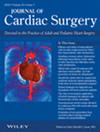Superior Vena Cava Canulation During Minimally Invasive Cardiac Surgery: A Better Choice than Percutaneous Internal Jugular Vein for Venous Drainage
Abstract
Backgrounds
Venous drainage is a critical aspect of peripheral cardiopulmonary bypass (CPB) management in minimally invasive cardiac surgery (MICS), particularly for superior vena cava (SVC) drainage. The most commonly used method for SVC drainage currently is percutaneous cannulation via the internal jugular vein. However, this method still faces challenges in drainage efficiency, cosmetic outcomes, and puncture-related complications. This study aimed to compare the safety, effectiveness, and cosmetic outcomes of direct SVC cannulation (SVCC) and percutaneous internal jugular vein (PIJV) for SVC drainage in MICS.
Methods
A retrospective analysis was conducted of patients who underwent MICS with CPB at the Cardiovascular Surgery Department of the First Affiliated Hospital of Jinan University and Guangdong General Hospital between January 2012 and August 2023. In this study, 499 patients underwent SVCC, and 572 patients received PIJV for SVC drainage.
Results
In the SVCC group, one central venous catheter was mistakenly fixed with a purse-string suture (0.2%). In the PIJV group, complications included neck hematoma in 11 cases (1.9%), puncture site infection in 3 cases (0.5%), and catheter failure in 1 case (0.2%). Significant differences were noted in central venous pressure (CVP) during aortic cross-clamping (p < 0.001), duration of mechanical ventilation (p = 0.049), pleural drainage volume (p = 0.001) and lactate levels at Intensive Care Unit (ICU) admission (p < 0.001) between the two groups. Additionally, lactate levels were significantly different only in the subgroup of patients weighing > 50 kg. Patients with a CVP ≤ 0 mmHg during aortic cross-clamping exhibited lower lactate levels on ICU admission than those with CVP > 0 mmHg.
Conclusion
SVCC in MICS provides an easy and safe method with minimal complications, improved venous drainage, and better cosmetic results than the PIJV method.


 求助内容:
求助内容: 应助结果提醒方式:
应助结果提醒方式:


